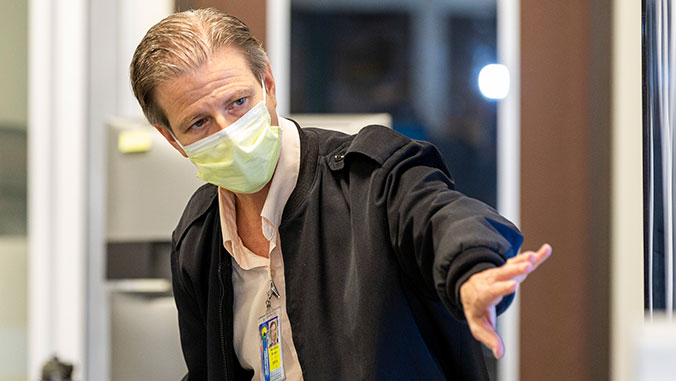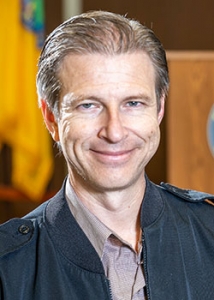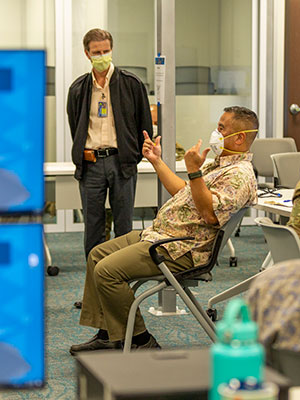
University of Hawaiʻi researchers, faculty members and graduates are playing a significant role in the state’s response to the COVID-19 pandemic. One high profile example is Steven Hankins, a family medicine physician and UH Mānoa John A. Burns School of Medicine (JABSOM) graduate/alumnus. Hankins teaches in JABSOM’s Department of Family Medicine and Community Health, where he has served as the director and is currently the associate director.

Since early April, he has been serving on the Hawaiʻi Emergency Management Agency (HI-EMA) COVID-19 Emergency Response Team, leading the Public Health and Medical Services Emergency Support Function (ESF 8) group, one of many ESFs that may be mobilized in a statewide crisis.
Hankins is uniquely qualified for the role with his knowledge and contacts in the local medical and public health communities and his years of national experience working with multiple government agencies during disaster responses.
“I really see my role, and have approached my role, as a weaver if you will, to take those strands of public health and medical services and weave them together into an integrated fabric so we have the most effective, efficient and robust response possible,” said Hankins. “Working in JABSOM has given me this amazing set of connections, not only to the academic side of the health care sector, but to the broader health care sector. That knowledge has been extremely helpful.”
Wide expertise
Hankins holds a master’s degree in public health with a certificate in emergency preparedness and disaster response from Johns Hopkins University. Prior to entering medical school, he received a master’s of theological studies at Harvard.
He served as a commissioned officer in the U.S. Public Health Service for seven years, specializing in emergency preparedness and disaster response. In that role, he delivered direct medical care to some of our nation’s most vulnerable communities and deployed to areas hard hit by Hurricane Katrina in 2005 and was attached to the Baltimore City Health Department in Maryland during the 2009 H1N1 flu outbreak.
Dr. Hankins is an immense asset to HI-EMA and the state during this unprecedented crisis.
—Luke Meyers,
HI-EMA Administrator
“With his knowledge and expertise in the areas of not only medicine but also in emergency management, Dr. Hankins is an immense asset to HI-EMA and the state during this unprecedented crisis,” said HI-EMA Administrator Luke Meyers.
Hankins was initially brought in as a subject matter expert by HI-EMA in early April and was soon asked to assist with coordinating the HI-EMA Public Health & Medical Services ESF at the State Emergency Operations Center. This group, in coordination with the Department of Health, is responsible for supporting disease prevention and containment, healthcare and medical response, environmental health and safety response, behavioral health services, healthcare infrastructure protection/assessment, medical shelters and mass patient movement.
“When we finally look back on this pandemic, we want to have reduced the overall illness and death in the state of Hawaiʻi related to all of the impacts of COVID-19—not just from the virus itself, but all of the health effects that come from the disruption of healthcare and other critical services. We must also mitigate the health-related consequences of the economic impacts across all of our sectors, short- and long-term,” said Hankins. “It is this goal of minimizing the total illness and death that really drives what we do.”
UH’s critical role

He is seeing firsthand the critical role UH serves in the pandemic response. Several people on his team are UH faculty or trained in the UH system.
“The amount of capacity that has been added to Hawaiʻi’s response system, through UH, is just tremendous,” said Hankins. “There are skills that I learned as a medical student at JABSOM that I apply everyday as we work through this crisis response. Part of that is how to approach complex problems in a thoughtful and methodical manner. And how to take huge volumes of complex information and be able to digest it, process it and organize it, and then share it in a way that is meaningful.”
As far as his outlook for Hawaiʻi, Hankins said the state was lucky because authorities took decisive action in implementing protective measures before the virus spread to the degree seen in many other locations. He is quick to acknowledge that the situation is far from over. From his previous experience responding to crises, however, he knows that “by coming together as a community and by all doing our part we will be able to minimize the impacts of COVID-19.”
“What gets communities through any disaster is that connectedness to each other, taking care of neighbors, looking out for the vulnerable,” he said. “This is really about our kuleana to our ʻohana and kupuna and really working together to make this come out with the best possible outcomes for health and well-being in our community. This is work very consistent with our vision at the John A. Burns School of Medicine which is ‘to Attain Lasting Optimal Health for All’ or ALOHA, for short.”

